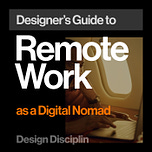Supported by:
Daylight Computer: the healthiest computer
Baked Graphics: amazing 3D video mockups
Framer: the best website builder for designers
ProtoPie: the best hi-fidelity interface prototyping tool
We have people tuning in to Design Disciplin from more than 200 countries all over the world. I know that remote work is a very interesting topic for many of you. And it's a topic that's very dear to my heart.
Let me explain.
I'm originally Turkish, and grew up in Istanbul. I went to school for mechanical engineering because I love to build things. And as an engineering student, I discovered computer programming. I turned quickly to building software as my way to make a living.
Early in my career, working at startups and freelancing as a web designer, I realized that the level of craft I wanted to reach as a designer and builder was not common in my country. To level up, first I signed up for grad school and worked my way to a PhD in design. That gave me access to an international community, and allowed me to move to Sweden, where the ecosystem around design and tech is mature.
If you're starting out today as a creative or technologist, it's critical that you understand this: The kind of work that you want to do – and the level of quality that you want to do it at – might not actually exist in the place where you were born.
Hundreds of people visit Design Disciplin every month from countries like India, Turkey, Indonesia, Vietnam, Guatemala, Malaysia, and Pakistan, where opportunities for designers and innovators are simply not at the same level as in Europe and the US. The level of competence and maturity you find at your employers, the level of quality that people care about, and as a result of these, the level of compensation that you're paid can be very different based on where you're located.
If you're reading this, you probably care about doing great work in your chosen discipline – and getting paid well for doing it. To achieve this, you might have to work remotely.
If you have the opportunity, you could also move to a new ecosystem. In that case too, to sustain relationships at home, and to capture opportunities that come with being internationally present, you'll be well advised to master the best tactics for remote work.
But of course, aspiring creatives who are just starting out are not the only ones who could benefit from transcending borders. I'm sure that many of you out there – such as myself – are mid-career and looking to expand, professionally as well as personally, beyond the borders they find themselves in.
Because the ability to work remotely, to free ourselves from geographical constraints with regard to our employment, is a superpower of creatives in the 21st century. Design is one of the most compatible jobs with remote working.
And I’m here to tell you about how to make the most of your experience as a remote-working, nomadic designer.
In our latest video and podcast episode, I'm excited to offer you 4 ideas that will help you prepare yourself for a productive time working remotely: Not only in terms of getting work done, but also in terms of making the most of your nomadic experience.
These are some of the things I learned as an experienced designer and experienced traveler, that I wish I knew when I started out.
Enjoy!
Share
Resources that Inspired this Episode
The Creative Act: A Way of Being by Rick Rubin
The 4-hour Workweek by Tim Ferriss
Rework by Jason Fried & DHH
Org Design for Design Orgs by Peter Merholz and Kristin Skinner
Principles for Dealing with the Changing World Order by Ray Dalio











Share this post